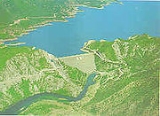
Almus Dam
Encyclopedia
The Almus Dam is an earthen embankment dam
that is near the town of Almus
(28 kilometers East of Tokat
city in center north of Turkey
) and is located on the River Yesilirmak which runs into the Black Sea
. The main purposes of the dam is irrigation
, flood control
and hydroelectricity
. The hydroelectric power plant (established in 1966) at the dam has a capacity of 27 megawatts (three facilities at 9 megawatts each). The dam contains 3405000 cubic metre of material and irrigates an area of 21,350 hectares. The dam's spillway
is capable of discharging a maximum 2800 m3/s and its bottom outlet a maximum of 50 m3/s
Embankment dam
An embankment dam is a massive artificial water barrier. It is typically created by the emplacement and compaction of a complex semi-plastic mound of various compositions of soil, sand, clay and/or rock. It has a semi-permanent waterproof natural covering for its surface, and a dense, waterproof...
that is near the town of Almus
Almus
Almus is a town and a district of Tokat Province in the Black Sea region of Turkey. The mayor is Hasan Hüseyin Arıkan ....
(28 kilometers East of Tokat
Tokat
Tokat is the capital city of Tokat Province of Turkey, at the mid Black Sea region of Anatolia. According to the 2009 census, the city of Tokat has a population of 129,879.-History:Tokat was established in the Hittite era....
city in center north of Turkey
Turkey
Turkey , known officially as the Republic of Turkey , is a Eurasian country located in Western Asia and in East Thrace in Southeastern Europe...
) and is located on the River Yesilirmak which runs into the Black Sea
Black Sea
The Black Sea is bounded by Europe, Anatolia and the Caucasus and is ultimately connected to the Atlantic Ocean via the Mediterranean and the Aegean seas and various straits. The Bosphorus strait connects it to the Sea of Marmara, and the strait of the Dardanelles connects that sea to the Aegean...
. The main purposes of the dam is irrigation
Irrigation
Irrigation may be defined as the science of artificial application of water to the land or soil. It is used to assist in the growing of agricultural crops, maintenance of landscapes, and revegetation of disturbed soils in dry areas and during periods of inadequate rainfall...
, flood control
Flood control
In communications, flood control is a feature of many communication protocols designed to prevent overwhelming of a destination receiver. Such controls can be implemented either in software or in hardware, and will often request that the message be resent after the receiver has finished...
and hydroelectricity
Hydroelectricity
Hydroelectricity is the term referring to electricity generated by hydropower; the production of electrical power through the use of the gravitational force of falling or flowing water. It is the most widely used form of renewable energy...
. The hydroelectric power plant (established in 1966) at the dam has a capacity of 27 megawatts (three facilities at 9 megawatts each). The dam contains 3405000 cubic metre of material and irrigates an area of 21,350 hectares. The dam's spillway
Spillway
A spillway is a structure used to provide the controlled release of flows from a dam or levee into a downstream area, typically being the river that was dammed. In the UK they may be known as overflow channels. Spillways release floods so that the water does not overtop and damage or even destroy...
is capable of discharging a maximum 2800 m3/s and its bottom outlet a maximum of 50 m3/s

